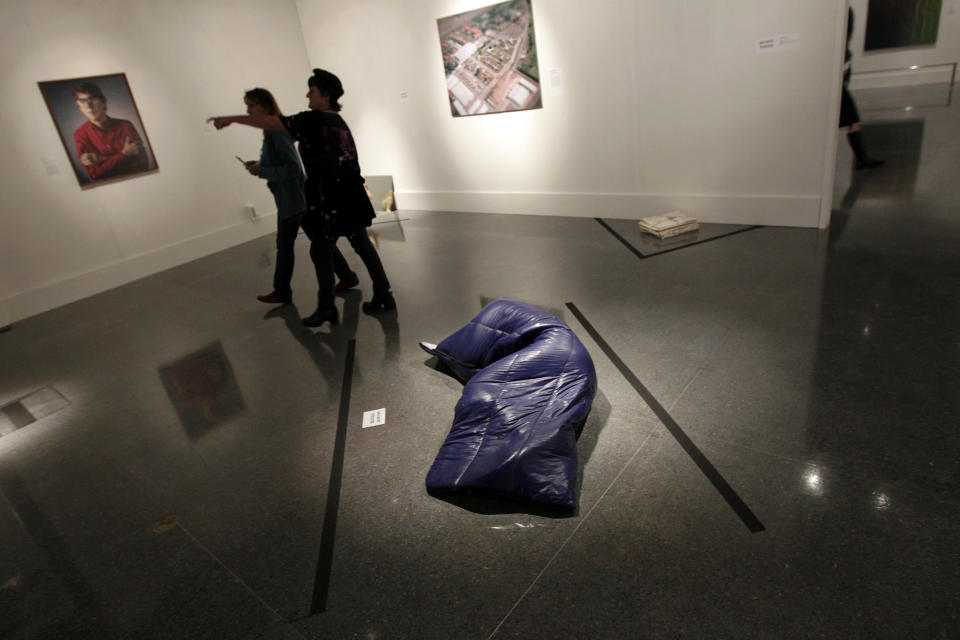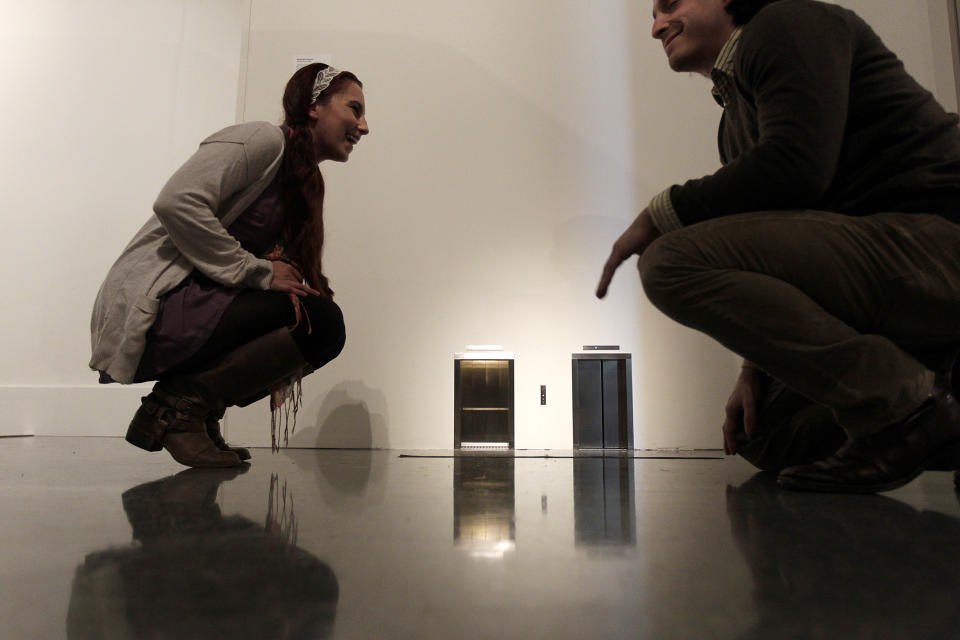Realistic art from pop to now at NOLA museum
NEW ORLEANS (AP) — It's art that tempts you. All those "do not touch" signs are essential.
You want to poke at Jud Nelson's "Hefty 2-Ply" to confirm that the full trash bag really is carved from marble. You want to touch a tentative fingertip to tiny weeds that seem to sprout from the floor and wall, and to clamber onto a folding chair with a shoulder-high seat.
They're all part of "Lifelike," a traveling exhibit at the New Orleans Museum of Art through Jan. 27.
Thomas Demand's video "Rain/Regen" creates the illusion of rain with 7,800 stop-action frames of cellophane candy wrappers and the sound of frying eggs. A 1950s-style folding table is big enough for Abraham Lincoln to walk beneath, while a nearby pair of elevators has operating doors 8 inches high — 3 ½ inches shorter than Barbie.
"What is real? What does it mean when images and objects cannot be relied upon to tell the truth?" said Miranda Lash, NOMA's curator of modern and contemporary art. "I think it's a question all the more relevant now, in the age of Photoshop and digital manipulation, of a world where images can be misleading. ... I think artists are very aware of that conundrum. They play with that."
Siri Engberg, curator at the Walker Art Museum in Minneapolis, brought together the exhibition of work by 55 artists from Andy Warhol and Jasper Johns to Mungo Thomson and Ai Weiwei, who was artistic consultant for China's "bird's nest" Olympic stadium. It will move next to the Museum of Contemporary Art in San Diego (Feb. 24-May 26) and the University of Texas at Austin's Blanton Museum of Art (June 23-Sept. 29).
Engberg said she had been struck by the number of younger artists who are meticulously recreating mundane objects by hand in an age of easier and more accessible mass production, and wanted to show the history of hyper-realism from the '60s to young artists like Yoshihiro Suda and Vija Celmins.
"They are not photorealists doing slick urban scenes or shiny cars or diners. These are things like a paper bag, an eraser, a comb — very ordinary objects they brought back to life by remaking them," Engberg said.
The exhibit is both chronological, from the pop art of Warhol's oversized wooden Brillo boxes to Demand's "Rain/Regen" (the same word in German, his native tongue), and thematic. "Common Objects," with Celmins' 20-inch-long wooden Eberhard Faber eraser and photorealistic paintings by Robert Bechtle, flows into "The Uncanny," which includes a painted bronze life-sized sculpture of a blue nylon sleeping bag with a hidden occupant curled up inside.
"I love that the show starts with pop," Lash said. "If it was just contemporary art, I think it would be hard for the public to understand where so many artists working today are coming from. They are children of pop, or grew up with that as part of their practical knowledge."
Other areas are "Realism Into Abstraction," ''Handmade Sleight of Hand," and "Special Effects: The Real as Spectacle."
It took a team of eight to 10 men with heavy machinery to get the table and chairs off of flatbed trucks, out of their crates and into place.
Other work is less obvious. A pair of low-power binoculars might be useful to see the details of Susan Collins' "Forever Young," which looks like junk boards and rags but was fashioned from fine woods, mother of pearl, and precious and semiprecious metals and stones including silver, gold and black diamonds.
That's only one way the exhibit raises questions about value, Lash said.
"If I invest hundreds of hours into something, is that a measure of value? There's certainly a number of artworks that make this argument that time is as much a measure of currency as anything else."
Some, like Suda's meticulously replicated "Weeds," are deliberately hard to spot.
"He's an artist that truly understands subtlety," Lash said. "Each leaf is made of wood and painted and crafted so well that it looks entirely convincing. It's a feat of craftsmanship. But it's deliberately placed in a corner, out of the way — just as weeds grow out of the crevices. I love the fact that you have to be attentive to see it."
___
Online:
New Orleans Museum of Art: www.noma.org
www.walkerart.org/
www.mcasd.org/
http://blantonmuseum.org/







